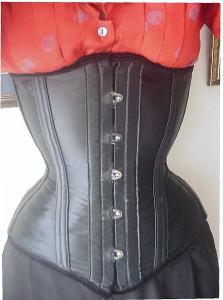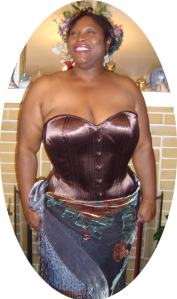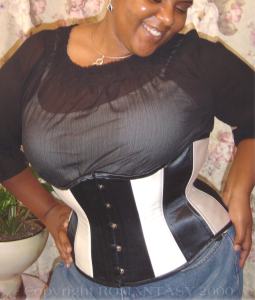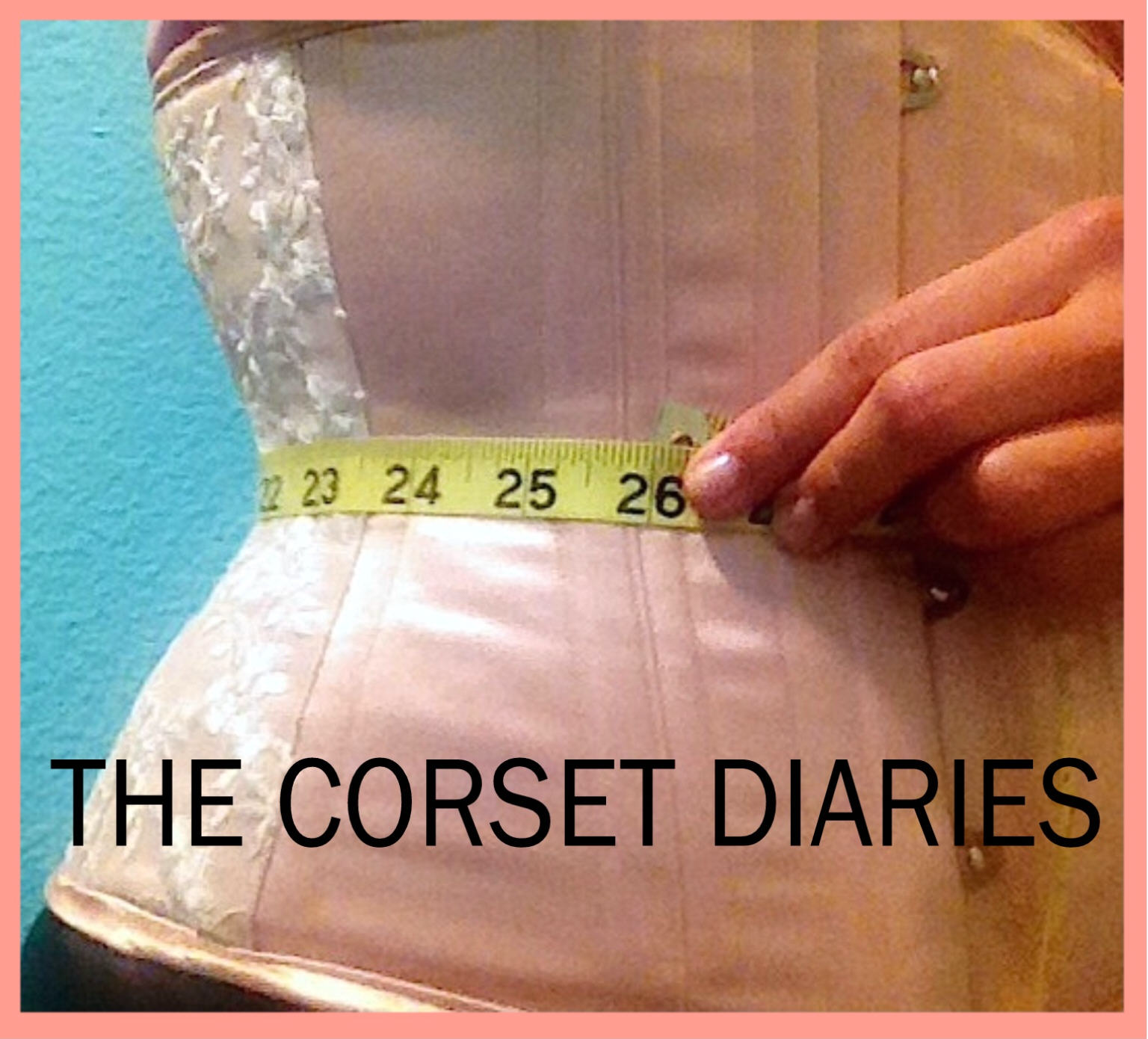I’ve always been one to speak up about policies and procedures that make no sense, or about something that I feel will improve my family, community or personal life. That also includes corsets.
Some who first considering wearing a corset, equate them with being from the fringe or the fetish world. Some see only the sexual aspect of corseting, not realizing that corsets are worn for a countless number of distinct, beneficial reasons (See corset enthusiast/corset maker Lucy William’s book, Solaced, available on amazon.com). Some fear that being identified with corsets by letter writing, or by wearing the corset as an outer fashion garment, or even by stealthing and being outed in some way, will bring opprobrium down on their head. They don’t see sufficient benefit of posting public comments or writing letters to editors or to authors of articles to correct wrong statements about corsets, to provide personal examples of positive benefits, or to make comments on style, design, and construction. I wonder how truly harmful those comments would be, really, or even if they would hear any at all? Most folks are into their own things and go about their business with little regard for others who might be tangential.
Perhaps we succumb to imagined trauma when there is none these days? Corsets are worn visibly and are ubiquitous outside of a fetish content. With nearly 400 international corset makers showing their wares on the web and rushing out gorgeous custom creations to hundreds if not thousands of clients all over the world?
 A rather new BFF of mine is subject to the connection of wearing corsets with both delight, and with shame. Recently she picked up a stunning, comfy and well fitting new overbust corset by Sheri (pictured here with lavendar paisley corset fitting properly; note there is no “toothpaste” protruding underneathe her arms; nor in the back which is not pictured) who is now our preferred ROMANTASY CORSETIERE (send us email for a direct referral to work with Sheri on your design and style needs).
A rather new BFF of mine is subject to the connection of wearing corsets with both delight, and with shame. Recently she picked up a stunning, comfy and well fitting new overbust corset by Sheri (pictured here with lavendar paisley corset fitting properly; note there is no “toothpaste” protruding underneathe her arms; nor in the back which is not pictured) who is now our preferred ROMANTASY CORSETIERE (send us email for a direct referral to work with Sheri on your design and style needs).
My friend doesn’t feel comfortable enough to let her 40-year old daughter know that she is wearing a corset as a foundation garment, yet her daughter commented on her good posture and lovely bosom supported properly by an overbust style. In addition, she has gotten many favorable comments even tho viewers don’t know she is wearing a corset, many along the lines of “Wow–you look great; that inspires me to start losing some weight too!”
Her daughter questioned the height of her mom’s bosom in the corset. Of course the corset needs some seasoning to fit better over time, and it needs to be pulled a bit down on my friend’s body (with the lean-pull technique).
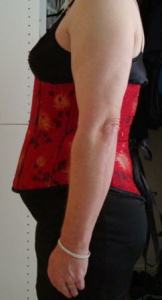 As another example, the client, not my new friend, pictured here is wearing a red Chinese polysilk underbust style corset too high on her torso, allowing her lower stomach to protrude outward. She pulled the corset down about one inch and lo! it fit perfectly!
As another example, the client, not my new friend, pictured here is wearing a red Chinese polysilk underbust style corset too high on her torso, allowing her lower stomach to protrude outward. She pulled the corset down about one inch and lo! it fit perfectly!
My BFF needs to remember that a corset tends to rise when sitting for a while, and over a day of wearing. Wearing a corset takes some attention and some tinkering with height and lacing down; the best fit requires some adjustment during the day until the corset settles on the body. Of course, we’re so used to seeing ourselves slump under loose clothing styles, that just seeing better posture looking back in the mirror can be stunning, even shocking, and take some getting used to. Most of all, my newly-corseting friend needs to heed my advice to delay any negative — or positive ultimate conclusion if corsets are for her or not.
Aside from potential negative or ill-informed comments that need to be corrected when they occur in the media, often corsets in the news are simply left out in any discussion about health or body size or shape, or about fat, obesity, and diet challenges.
That’s true of one New York Times Magazine’s article from this past Sunday (see below). It’s as if corsets and corset waist training just don’t exist, much like society has treated women as not existing in conversations conducted and dominated by men in the boardroom and conference hall. Women have to push their way in and speak up to be heard; it takes courage. Courage is more important than courtesy, as Senator Kamala Harris believes (she’s publishing a button with that saying, and I’m waiting for mine to wear proudly).
I urge you to consider pushing your way into any misguided corset conversation, or where your informed comment may be relevant, so that these wonderful garments and their many benefits become more broadly available in the consciousness of anyone who wants to improve their posture and/or lose weight or waistline inches. It’s one more option of self-improvement that has nothing to do with dieting and everything to do with feeling good, fashionable, feminine, comfy, and au courant!! We need every voice to speak up to address “The Corset Question” and diminish it’s ludicrousness and invented foundational belief that corsets cause pain.
On another point, one person reminded me to confront statements like I used to make, that modern day corsetry well fit and custom, is a lot more comfy than Victorian corsets were. But that’s simply not true — or women would have been complaining and not wearing them a long time ago! Any custom corset properly fit, then slowly seasoned and worn properly on the torso and with respect to the body’s messages about comfort and health, can be beneficial, and almost never detrimental to health and well being if common sense is applied in the wearing.
If you want to know how to safely and sanely waist train, check out what a doctor, nutritionist, and corsetmaker say about my new “how to waist train” primer book (just $14.95 online). It can help ease your way into comfy waist training, and avoid most pesky problems that might occur for some.
###
Letter to the Editor, New York Times 8/8/17
Dear Editor:
I feel for Taffy Brodesser-Akner’s angst about weight (“Losing It”, NYT Magazine 8/6/17). However, the public obsession pro or con fat (or whatever PC term we are supposed to use now), is about sexism at base. Women at the other end of the weight spectrum get trashed, too. Society thinks it’s just fine to lob cruel public comments at thin and fat women. What’s sad is that Taffy has not found anything to help but the old saws of superfoods, bariatric surgery, and the like. She could think entirely out of the box, and try corset waist training. It’s a fashionable and fun approach that’s completely unrelated to dieting. Simply don a beautifully crafted custom corset to immediately improve posture plus comfortably nip inches off any persons’s waistline. Soon looking better translates into feeling better, as do the positive public comments you’ll receive. Meanwhile the corset mandates portion control: overeat and the resulting discomfort reminds you to resist the next time you eat. I’ve coached students in the initial three-month process for 25 years. Wearing a corset gives them time for stomachs to become less elastic, and encourages the development of new, beneficial nutrition, food, and exercise choices. It shrinks the waistline in an amazingly short time, and you can lose weight if you want to. Better yet, like wearing panties or a bra, wearing a comfy corset occasionally becomes second nature to a woman so that we continue to reap the lifelong rewards of the initial success that every single student I’ve coached has experienced. ###






